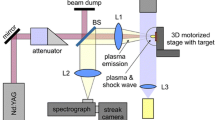Abstract
A technique based on laser-induced breakdown spectroscopy (LIBS) is proposed for detecting in-situ dust on the plasma-exposed surfaces and in the grooves of plasmafacing components in the next-generation of fusion devices (e.g., ITER-FEAT). It is based on laser-induced ablation of wall material and spectral analysis of the laser spark flash-light collected by imaging optics and transmitted to the detection system. This could give space- and time-resolved information on the presence of dust, or loosely bound films, their characteristic deposition patterns, elemental composition, and possibly their hydrogen content, without the necessity of breaking the machine vacuum. We have performed some simple proof-of-principle experiments to demonstrate the suitability of this technique, which might provide an effective non-intrusive in-situ surface analysis method for surveying in-vessel dust accumulation in future fusion devices.
Access this chapter
Tax calculation will be finalised at checkout
Purchases are for personal use only
Preview
Unable to display preview. Download preview PDF.
Similar content being viewed by others
References
G. Federici, et al., Plasma-material interactions in current tokamaks and their implications for next-step fusion reactors, submitted to Nucl Fusion.
G. Federici, et al. (1999) In-Vessel tritium retention and removal in ITER, J. Nucl. Mater. 266-269 14–19.
G. Janeschitz. (2001) Plasma wall interactions in ITER FEAT, J. Nucl. Mater. 290-293 1–15.
K.A. McCarthy, D.A. Petti, W.J. Carmack, and S.V. Gorman. (1998) Tokamak dust in ITER—saefty issues and R&D supporting dust limits, Fus. Technol. 34 728–735.
G.F. Counsell, et al. (2001) Towards an improved understanding of the relationship between plasma edge and materials issues in a next-step fusion device, J. Nucl. Mater. 290-293 255–261.
J.P. Coad, M. Rubel, C.H. Wu. (1997) The amount and distribution of deuterium retained in the JET divertor after the C and Be phases in 1994–1995, J. Nucl. Mater. 241-243 408–413.
M. Rubel, J. Von Seggern, P. Karduck, V. Philipps, A. Vevecka-Priftaj. (1999) Analysis and oxidation of thick deposits on TEXTOR plasma-facing components, J. Nucl. Mater. 266-269 1185–1193.
D.G. Whyte, et al., DiMES divertor erosion experiments in DIII-D, J. Nucl. Mater. 241-243 (1997) 660–667.
K. Krieger, et al. (1997) Study of gross and net erosion in the ASDEX-Upgrade divertor, J. Nucl. Mater. 241-243 684–691.
V. Rohde, H., Maier, K., Krieger, R., Neu, J., Perchermaier. (2001) Carbon layers in the divertor of ASDEX-Upgrade, J. Nucl. Mater. 290-293 317–324.
R. Reichle, et al. (2001) Thermography of target plates with near infrared optical fibres at Tore Supra, J. Nucl. Mater. 290-293 701–709.
D. Summers, et al. (2001) In-situ measurement of hydrogen retention in JET carbon tiles, J. Nucl. Mater. 290-293 496–503.
M.M. Menon, et al. (1999) Study of the surface features on the TFTR inner limiter using a frequency modulated coherent laser radar device devloped for ITER, in Proc. 18th IEEE/NPSS Symp. on Fus. Eng. (Albuquerque, Oct. 6–10, 1999), Ed. IEEE, Piscataway—New Jersey, IEEE 99CH3705 pp. 261–268.
R.C. Isler. (1984) Impurities in tokamaks, Nucl. Fusion 24 1599–1607.
R. Neu, et al. (2001) Plasma operation with tungsten tiles at the central column of the ASDEX-Upgrade, J. Nucl. Mater. 290-293 206–211.
F. Brech and L. Cross. (1962) Optical microemission stimulated by a ruby laser, Appl. Spectrosc. 16 59–64.
R.S. Adrain and J. Watson. (1984) Laser microspectral analysis: a review of principles and applications, J. Phys. D: Appl. Phys. 17 1915–1921.
D.A. Rusak, B.C. Castle, B.W. Smith and J.D. Winefordner (1997) Fundamentals and applications of laser-induced breakdown spectroscopy, Critical reviews in analytical chemistry, 27 257–264.
K. Song, Y.I. Lee and J. Sneddon. (1997) Applications of laser-induced breakdown spectroscopy, Appl. Spectrosc. Rev. 32 183–190
O.B. Anan’in, Yu.A. Bykovsky, E.L. Stupitsky, A.M. Khudaverdyan. (1987) Shock wave structure of the laser plasma expanding in rarefied gas, Kvantovaya electonica (Quantum Electronics, Sov.) 14 2313–2319
J.P. Coad, et al., Erosion/deposition issues at JET. (2001) J. Nucl. Mater. 290-293 224–231.
V.I. Luchin, (1980) Izvestiya vuzov, Radiofisika (Proc. High Education Schools Radiophysics, Sov.) 23, 176–181.
A.G. Gaydon. (1957) The spectroscopy of flames, London, Chapman and Hall Ltd,.
L. De Kock, et al., (1998) Diagnostic requirements for the ITER divertor, in P.E. Stott et al (eds.) Diagnostics for Experimental Thermonuclear Fusion Reactors 2, Plenum Press, New York and London p. 67–73.
A. von Engel. (1994) Ionized gases, American Institute of Physics, New York
C.I. Walker, et al. (1998) Diagnostic access for ITER, in P.E. Stott et al (eds) Diagnostics for Experimental Thermonuclear Fusion Reactors 2, Plenum Press, New York and Londonp. 57–63.
Author information
Authors and Affiliations
Editor information
Editors and Affiliations
Rights and permissions
Copyright information
© 2002 Springer Science+Business Media Dordrecht
About this chapter
Cite this chapter
Kozhevin, V.M., Mukhin, E.E., Razdobarin, G.T., Semenov, V.V., Tolstyakov, S.Y., Federici, G. (2002). Laser Induced Breakdown Spectroscopy Technique For In-Situ Dust Detecting In A Next-Step Tokamak. In: Hassanein, A. (eds) Hydrogen and Helium Recycling at Plasma Facing Materials. NATO Science Series, vol 54. Springer, Dordrecht. https://doi.org/10.1007/978-94-010-0444-2_22
Download citation
DOI: https://doi.org/10.1007/978-94-010-0444-2_22
Publisher Name: Springer, Dordrecht
Print ISBN: 978-1-4020-0512-1
Online ISBN: 978-94-010-0444-2
eBook Packages: Springer Book Archive



